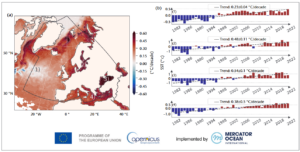The State of the Climate in Europe 2022 report was published today, and it is the second edition of this annual series. This joint publication by the World Meteorological Organization (WMO) and the European Union’s Copernicus Climate Change Service summarizes the state of the climate, and the extreme and high-impact weather and climate events in 2022 for the Regional Association for Europe WMO RA VI (Europe) domain, in the context of long-term climate variability and climate change. Mercator Ocean International has contributed with analysis surrounding sea surface temperature, ocean heat content and marine heatwaves, supported with Copernicus Marine Service data and indicators.
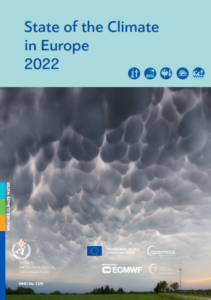 Source: State of the Climate in Europe 2022, report cover
Source: State of the Climate in Europe 2022, report cover
Report findings for the ocean
For this European-focused report, the WMO defines the scope of analysis, Region VI, which includes several major ocean basins, subregions and big lakes: the eastern Atlantic sector of the Arctic, the North, Baltic, Mediterranean and Black Seas, as well as part of the Caspian Sea. These areas have significant influence on the climate and weather conditions of the region, and they are strongly affected by both global and regional changes in the climate. Much of the text below is taken directly from the report.
Ocean warming and sea level rise
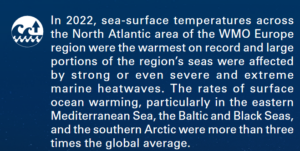 Source: State of the Climate in Europe 2022
Source: State of the Climate in Europe 2022
- In 2022, sea-surface temperatures across the North Atlantic area of the WMO Europe region were the warmest on record and large portions of the region’s seas were affected by strong or even severe and extreme marine heatwaves.
- Regional rates of surface ocean warming, particularly in the eastern Mediterranean Sea, the Baltic and Black Seas, and the southern Arctic were more than three times the global average.
Caption: (a) Trends in SST (°C per decade) over the period 1982–2022. (b) Area-averaged time series of SST anomalies (°C) relative to the 1982–2022 reference period for the areas indicated on 7(a): 1) North Atlantic; 2) Baltic Sea; 3) Black Sea; and 4) Mediterranean Sea. The WMO area for Europe is indicated with a black line. Figure: State of the Climate in Europe 2022. Source: Mercator Ocean International/Copernicus Marine Service. Derived from the remote sensing product for 1982–2021 (see https://doi.org/10.48670/moi-00168), and for 2022 (see https://doi.org/10.48670/moi-00165), downloaded from the Copernicus Marine Service
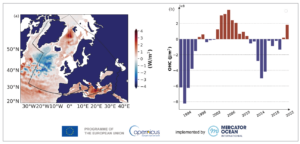 Caption: (a) Regional ocean heat content (0–700 m depth) anomalies for 2022 (relative to 2005–2022 climatology). The WMO area for Europe is indicated with a black line. White areas indicate regions where the ocean is shallower than 300 m, which have been excluded in this analysis due to limitations in ocean measurement density. (b) Ocean heat content annual anomalies over the period 1993–2022 (relative to 2005–2022 climatology). Figure: State of the Climate in Europe 2022. Source: Mercator Ocean International/Copernicus Marine Service, from an observational-based product distributed by the Copernicus Marine Service (https://doi.org/10.48670/moi-00052)
Caption: (a) Regional ocean heat content (0–700 m depth) anomalies for 2022 (relative to 2005–2022 climatology). The WMO area for Europe is indicated with a black line. White areas indicate regions where the ocean is shallower than 300 m, which have been excluded in this analysis due to limitations in ocean measurement density. (b) Ocean heat content annual anomalies over the period 1993–2022 (relative to 2005–2022 climatology). Figure: State of the Climate in Europe 2022. Source: Mercator Ocean International/Copernicus Marine Service, from an observational-based product distributed by the Copernicus Marine Service (https://doi.org/10.48670/moi-00052)
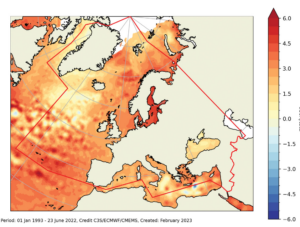 Caption: Sea-level trends (mm/year) from satellite altimetry from January 1993 to June 2022. The data have not been adjusted for glacial isostatic adjustment nor for the TOPEX-A instrumental drift. The red line indicates the WMO Region VI – Europe. Figure: State of the Climate in Europe 2022. Source: Copernicus Marine Service Ocean Monitoring Indicator, based on the C3S sea-level product.
Caption: Sea-level trends (mm/year) from satellite altimetry from January 1993 to June 2022. The data have not been adjusted for glacial isostatic adjustment nor for the TOPEX-A instrumental drift. The red line indicates the WMO Region VI – Europe. Figure: State of the Climate in Europe 2022. Source: Copernicus Marine Service Ocean Monitoring Indicator, based on the C3S sea-level product.
- Changes in mean sea level are a result of both the thermal expansion of the Ocean in response to warming and the loss of mass from ice sheets and glaciers.
- Since1993, global mean sea level has increased at an average rate of 3.4 ± 0.3 mm/year.
- Regionally, absolute sea-level trends as seen from satellites show spatial variations, with trends from 2–4 mm/year over most of the European seas.
Marine heatwaves
A marine heatwave refers to a prolonged period of abnormally high ocean temperatures within a specific region. In the context of human-induced global warming, the frequency, duration, and intensity of marine heatwaves are increasing significantly. They pose a significant risk to vital ecosystems, including coral reefs and seagrass beds, as well as for human populations and economies.
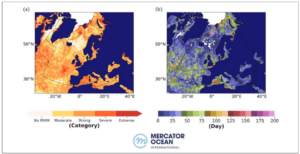 Caption: Map showing (a) the highest marine heatwave category (for definitions, see the Marine heatwave and marine cold spell subsection under Data sets and methods) experienced at each pixel in 2022 and (b) the maximum duration of marine heatwaves over the year 2022. Figure: State of the Climate in Europe 2022. Source: Mercator Ocean International, France. Derived from the remote sensing product https://doi.org/10.48670/moi-00168 for 1982–2021, and https://doi.org/10.48670/moi-00165 for 2022, downloaded from the Copernicus Marine Service.
Caption: Map showing (a) the highest marine heatwave category (for definitions, see the Marine heatwave and marine cold spell subsection under Data sets and methods) experienced at each pixel in 2022 and (b) the maximum duration of marine heatwaves over the year 2022. Figure: State of the Climate in Europe 2022. Source: Mercator Ocean International, France. Derived from the remote sensing product https://doi.org/10.48670/moi-00168 for 1982–2021, and https://doi.org/10.48670/moi-00165 for 2022, downloaded from the Copernicus Marine Service.
- In 2022, large portions of the region were affected by strong or even severe and extreme marine heatwaves. Some marine heatwave periods lasted approximately 4–5 months, such as in the western Mediterranean Sea, the English Channel, the southern Arctic and the northern Barents and Kara Seas
- In the Mediterranean Sea, sea-surface temperature anomalies for summer 2022 (June–August) reached values as high as +4.6 °C locally, exceeding the values of summer 2003, which held the previous record high.
- Other areas affected by severe to extreme marine heatwaves lasting about 1–2 months include the western Mediterranean Sea, the Barents and Kara Seas, the south-western Baltic Sea, the North Sea and large parts of the North Atlantic Ocean (including to the south-west of Ireland and the Bay of Biscay area).
Sea ice
For this report, the European Arctic sector is defined as the Ocean area within 44°W–50°E, 63°–85°N (excluding the Baltic Sea).
- At its annual minimum in September, the monthly mean extent of the European Arctic sector was 6% below average, the fourteenth lowest in the 1979–2022 satellite record. It then remained consistently below average from October onwards. September 2022 was in sharp contrast with September 2021, when sea ice in the European Arctic sector reached its lowest extent on record, at 40% below average.
- Sea-ice extent in the Baltic Sea is often characterized by its winter maximum extent. During the 2021/2022 winter, a maximum of about 93 000 km2 was reached in early February, making the season a “weak ice winter”. This was the tenth lowest maximum extent within the last four decades and fifty-fifth lowest within the full data record of more than 300 years.
Mercator Ocean International’s contribution
Mercator Ocean International has contributed expertise surrounding Ocean warming, sea surface temperature, and marine heatwaves. Dr. Karina von Schuckmann, oceanographer at Mercator Ocean International, with the assistance of her team, led this contribution. She also led the MOi contributions to the latest WMO State of the Global Climate 2022. Von Schuckmann is globally recognized for her work on Ocean climate monitoring and was a lead author of the IPCC (AR6) WG1 6th assessment report (Chapter 2) as well as a lead author of the IPCC (AR6) Special Report on the Ocean and Cryosphere in a Changing Climate (Chapter 1). Most recently, she has led MOi participation in an initiative of leading scientists (that contributed to the IPCC report of working group 1 on climate change) in the development of an open data, open science platform – the Indicators of Global Climate Change.
The State of the Climate in Europe 2022 draws upon MOi expertise as well as Ocean data and indicators from the Copernicus Marine Service, implemented by MOi. As a sister service of the Copernicus Climate Change Service, various ocean indicators and datasets are collaboratively produced with the Copernicus Marine Service, including the global Sea Level Ocean Monitoring Indicator.
About the State of the Climate in Europe 2022 Report
The report makes use of climate observing systems and brings together valuable contributions from Members, while supporting their needs on climate monitoring, climate change and climate services. The latest data and information on impacts, risks and policy from United Nations agencies and European Union (EU) partners complement the physical science overview. The present report also considers the scientifically robust findings from the recent Sixth Assessment Report and Synthesis Report of the Intergovernmental Panel on Climate Change (IPCC), and from the Copernicus European State of the Climate 2022 report.
Europe is the fastest-warming of the six defined WMO regions and in 2022 many countries in western and south-western Europe had their warmest year on record. Summer was the hottest ever recorded: the high temperatures exacerbated the severe and widespread drought conditions, fuelled violent wildfires that resulted in the second largest burnt area on record, and led to thousands of heat-associated excess deaths.
Launch of the report: 19 June 2023 at 14:00 – 16:00 (Irish Standard Time) in Dublin City Hall, Dame St, Dublin, Ireland and online via Zoom in connection to the 6th European Climate Change Adaptation Conference 2023 (ECCA2023).
Important Links
- State of the Climate in Europe 2022: World Meteorological Organization and the Copernicus Climate Change Service
- MOi reports: New Indicators Project for Tracking Our Changing Climate
- MOi reports: WMO State of the Global Climate 2022: Mercator Ocean expertise contributes
- MOi reports: Global sea surface temperatures reach record high, April 2023
- MOi reports: Global Warming and the Ocean: a new study led by Mercator Ocean International expert sheds light on the Earth’s Energy Imbalance
- MOi reports: Record-high Marine Heatwaves in the Mediterranean Sea, Summer 2022 (cited in the WMO State of the Climate in Europe 2022)

